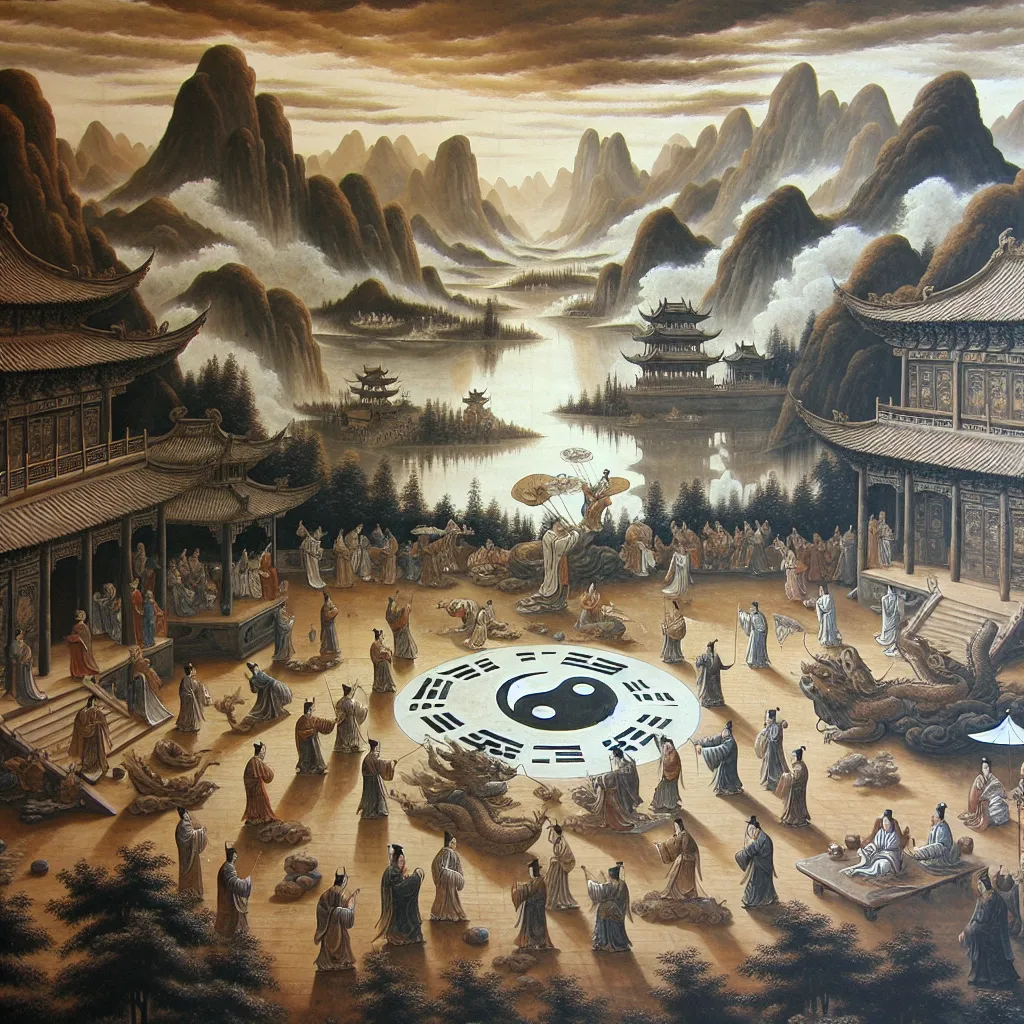
- Published on
- Authors

- Name
- You
The Influence of Taoism on Chinese Culture and Art
Taoism, one of the oldest and most influential philosophical traditions of China, has deeply permeated various facets of Chinese culture, especially art, literature, poetry, and traditional practices. Rooted in the concept of living harmoniously with the Tao (the Way), this ancient wisdom emphasizes simplicity, spontaneity, and tranquility. Let us delve into how this fascinating philosophy has left an indelible mark on Chinese cultural heritage.
Art: A Reflection of Taoist Principles
Paintings and Calligraphy
Taoist principles of naturalness (ziran 自然) and simplicity (jian 簡) are vividly manifested in Chinese landscape paintings and calligraphy.
| Element | Description |
|---|---|
| Landscape Painting | Artists aimed to capture the essence of nature, emphasizing fluidity and balance rather than meticulous detail. |
| Calligraphy | Taoist calligraphy is characterized by free-flowing brushstrokes, mirroring the natural and effortless movement of energy (Qi 氣). |
Taoism's reverence for nature is paramount in these forms of art, depicting mountains, rivers, and clouds to symbolize the eternal and ever-changing Tao.
Sculpture and Architecture
Traditional Taoist sculptures and architectural designs often feature intricate motifs of dragons, phoenixes, and other mythological creatures, symbolizing cosmic balance and harmony. Temples are constructed to align with feng shui principles, creating a physical embodiment of Taoist cosmology.
Literature and Poetry: The Taoist Voice
Taoist literature, particularly the works of Laozi (老子) and Zhuangzi (莊子), are fundamental to Chinese thought. These texts underscore the transience of life and the importance of living in accordance with the Tao.
Classic Texts
| Text | Author | Key Philosophical Concepts |
|---|---|---|
| Tao Te Ching | Laozi | Emphasizes wu wei (無為) - doing without doing, simplicity, humility, and yielding. |
| Zhuangzi | Zhuangzi | Advocates philosophical relativism, spontaneity, and the joy of freeing oneself from societal norms. |
The poetic genre, profoundly influenced by Taoism, celebrates nature, freedom, and the transcendence of worldly concerns. Many poems from the Tang and Song dynasties echo Taoist sentiments of detachment and the pursuit of inner peace.
Celebrated Poets
- Li Bai (李白): Known for his spontaneous and unrestrained style, reflecting Taoist ideals of freedom and naturalness.
- Wang Wei (王維): His works often convey serene and tranquil depictions of nature, mirroring Taoist thoughts on harmony and balance.
Traditional Practices
Meditation and Martial Arts
Taoist practice is not confined to intellectual pursuits but extends to physical disciplines such as Qigong (氣功) and Tai Chi (太極). These meditative exercises cultivate balance, health, and spiritual development, harmonizing body and mind with the Tao.
Rituals and Festivals
Taoist rituals and festivals, such as the Lunar New Year and Lantern Festival, are imbued with symbolic meanings and traditional practices. These ceremonies often involve:
- Offerings and Prayers: Seeking blessings and protection from deities.
- Dragon and Lion Dances: Representing the expulsion of evil spirits and the invocation of good fortune.
| Celebration | Rituals and Practices |
|---|---|
| Lunar New Year | Family reunions, feasts, red envelopes, and firecrackers to ward off bad luck. |
| Lantern Festival | Lantern parades, solving riddles on lanterns, and honoring ancestors. |
Conclusion
The interweaving of Taoism with Chinese culture has led to a rich tapestry of artistic expression, profound literary works, and enduring traditional practices. This harmonious blend of mystical wisdom and daily life continues to inspire and captivate people worldwide, offering a unique lens through which we can appreciate the depth and beauty of Chinese heritage. Through its tranquil yet profound teachings, Taoism remains a guiding light, illuminating the path toward a harmonious existence in the ever-evolving human journey.
